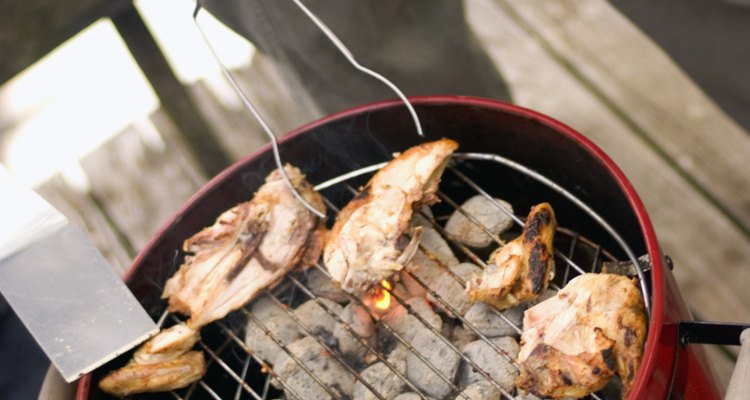
Though boneless chicken breasts are convenient and cook faster than bone-in chicken pieces, they are generally more expensive, and they don't give your chicken the same flavor profile. In addition to being more flavorful, bone-in chicken typically costs less and retains moisture better than typical boneless cuts. You can expect to spend more time cooking it, but you'll notice the difference in the end result.
Grilling and Baking
Whole, bone-in chicken takes longer to cook than boneless pieces, no matter the method. This is because of the way that heat radiates throughout the meat. In a boneless, skinless breast, there is no skin to retain moisture and no bones to conduct heat, so it cooks faster but can dry out. When you cook bone-in chicken with the skin on, though, the skin locks in moisture and the bone absorbs heat, so it takes longer but retains moisture. For example, while it may take about 20 minutes to grill a boneless, skinless chicken breast, a bone-in chicken can take 45 to 50 minutes.
Whole Vs. Pieces
The amount of time it takes to cook bone-in chicken depends also on its size. For example, while a bone-in chicken weighing about 3 1/2 pounds can take about 50 minutes to cook on the grill or roast in the oven, smaller pieces take considerably less time, even with the bone. grilled wings, for example, don't take any longer than boneless breasts -- about 20 minutes or so. If you want to cook bone-in chicken without investing more time than you would for boneless meat, break it up into smaller pieces.
Simmering the Chicken
In some recipes, bone-in chicken is preferable to boneless. When making chicken stock or chicken soup, for example, you should simmer chicken thighs with the bone in, because the bones add flavor to the broth. In recipes like this, you don't need to worry about adjusting your cooking time to accommodate the bones, because the chicken doesn't have to be cooked the whole way through before you strip it from the bones. After its initial simmer, you remove the meat from the bones and shred it, then cook it more -- if it's still partially uncooked in the middle when you shred it, it will finish cooking as you combine all of the soup's ingredients and let them simmer together.
Identifying Finished Chicken
Because of variations between cuts, bone densities, grill temperatures and more, you should never rely strictly on a recipe to identify when your chicken is done -- instead, check it with a meat thermometer. Whether your chicken is cooked bone-in or boneless, it should have a minimum internal temperature of 165 degrees Fahrenheit at its thickest part. You can cook bone-in chicken with the skin on it for longer without drying it out, but it should be no warmer inside than 190 F, or it will become tough and dry.
Related Articles

How to Broil Chicken on the Bone

How Hot Are You Supposed to Cook ...

How to Marinate BBQ Chicken Thighs & ...

How to Cook Turkey Parts

How to Cook Boneless Chicken Breasts in ...

How Long Would it Take to Bake a 1.6 Lb ...

Roast Chicken in Enameled Cast Iron

How to Cook Split Bone Turkey

The Best Ways to Make a Baked Moist and ...

How to Cook Chicken Thighs

How to Get a Crispy Crust on Roasted ...

How Do You Tuck the Wings to Roast a ...

How to Cook a Pheasant Breast So That ...

How to Cook Chicken Without a Grill

How to Cook a Thin Breaded Chicken ...

How to Cook Chicken Pieces in an ...

How to Cook a Chicken in a Toaster Oven ...

How to Cook a Frozen Burger in a Skillet

How to Cook a Crispy & Juicy Whole Duck

Can You Roast Whole Frying Chickens?
References
Writer Bio
Tom Ryan is a freelance writer, editor and English tutor. He graduated from the University of Pittsburgh with a degree in English writing, and has also worked as an arts and entertainment reporter with "The Pitt News" and a public relations and advertising copywriter with the Carnegie Library of Pittsburgh.
Photo Credits
Creatas/Creatas/Getty Images